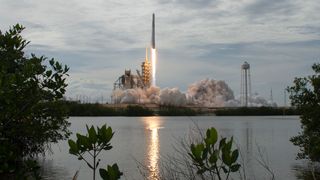On Monday morning, the Australian government announced its commitment to establishing a national space agency, as the “anchor for our domestic coordination and the front door for our international engagement”. It follows last week’s announcement by the South Australian Government that it will commit to the creation of the South Australian Space Industry Centre (SASIC), to ensure that South Australia is “the industry hub of a future space agency when and if it is formed by the federal government”.
The coalition government, the opposition, and the private sector, all seem to believe that an Australian space agency is necessary to foster Australian innovation and to increase the Australian economy’s 0.8 per cent share of the global industry, currently valued at approximately $420 billion. Yet, how do we gauge the potential of an Australian space agency to foster Australian innovation?
Some clues may exist in the precedents offered by the experience of the United States. Since the 1980s, the National Aeronautics and Space Agency (NASA) has pursued a path of promoting the commercialisation of space activities. The US government’s pursuit of space commercialisation has opened the doors to a range of private-sector actors and collaborations between NASA and private enterprise.
The International Space Station (ISS), launched by an international coalition of five space agencies in 1998, enabled NASA to develop a marketplace for space products and services in low-Earth orbit, and discover new business opportunities in partnership with the private sector. Since then, the ISS has helped foster innovations in a range of areas as diverse as agriculture, biomedicine, the Internet of Things, and vehicle safety systems. In fact, since its inception in 1976, NASA’s spinoff program has patented nearly 2,000 innovations that impact many aspects of our everyday lives.
Outside of NASA, the commercialisation of US space activities has led to innovations from a diverse range of private enterprises, all of which collaborate with NASA. The list includes multinational corporations such as Boeing and Lockheed Martin but also space start-up success stories such as SpaceX.
Since its inception in 1976, NASA’s spinoff program has patented nearly 2,000 innovations that impact many aspects of our everyday lives.
Since 2008, SpaceX has continued to achieve world-first milestones for the private space industry, and is fast becoming the world’s fastest growing provider of launch services. Earlier this year, the company successfully re-launched a rocket. SpaceX’s development of reusable rockets, in particular, will significantly reduce the cost of launches – a major constraint on space exploration . Other start-ups have now joined this ambitious work.
The aerospace industry in Australia already has strong capabilities. According to one report for the Department of Industry, Innovation and Science, Australia’s space industry is estimated to be worth $3-4 billion annually and employ up to 11,500 people. The industry also contains more than 30 tech start-ups Australia-wide, and more than 60 space-related organisations operate within South Australia alone. Universities across South Australia, ACT, and NSW are conducting world-class projects in this field. Australia’s unique geographical position make it an attractive partner for collaboration in space research and technology infrastructure. For more than 50 years, Australia has been involved in NASA’s Deep Space Network, with CSIRO managing and operating the Canberra Deep Space Communication Complex. Australia is also home to the European Space Agency’s New Norcia, and a partner in the Square Kilometre Array.
Moreover, the Australian aerospace industry is generating innovation. Australian start-ups in this sector recently raised $15 million in capital to support their work in developing miniature satellite technologies (cubesats), launch capabilities, and ground operational capabilities. Earlier this year, Australia launched its first cubesats into space, a feat thought unimaginable two years ago. Yet as proponents argue, including one leading space tech start-up CEO, the industry is fragmented. As a result, many space-related start-ups cannot afford to stay in Australia and face strong competition from start-ups overseas. Australia also suffers from a brain drain in this sector given the limitations of Australia’s space ambitions compared to elsewhere.
Australia’s national space industry association released a white paper which argued that Australia is not only dependent on space-related technologies for critical aspects of its communications, transport, defence and intelligence, and economic infrastructure but space also has clear implications for Australia’s national science and research priorities: food, soil and water, transport, cybersecurity, resources, environmental change, and health. The need for Australian innovation in space is clear. Yet Australia does not currently have assets in space and relies heavily on the capabilities of other countries for its own space programs.
NASA’s success in connecting government-led research and development with commercial enterprise provides a precedent to suggest that an Australian space agency that ties all industry stakeholders into closer collaboration would foster Australian innovation in space and in a diverse range of industries across the economy.
Today, the global space industry has grown from $290 billion in 2008, to $420 billion in 2017, and currently grows at three times the rate of global GDP. Once a government-dominated sector, only 23 per cent of the global space sector value came from governments in 2015. The focus of start-ups on the cost reduction of space access is contributing to wider access to the space industry. The importance of space to Australia and the current trends of the global industry make the space sector impossible to ignore in the development of an innovation-driven Australian economy.






